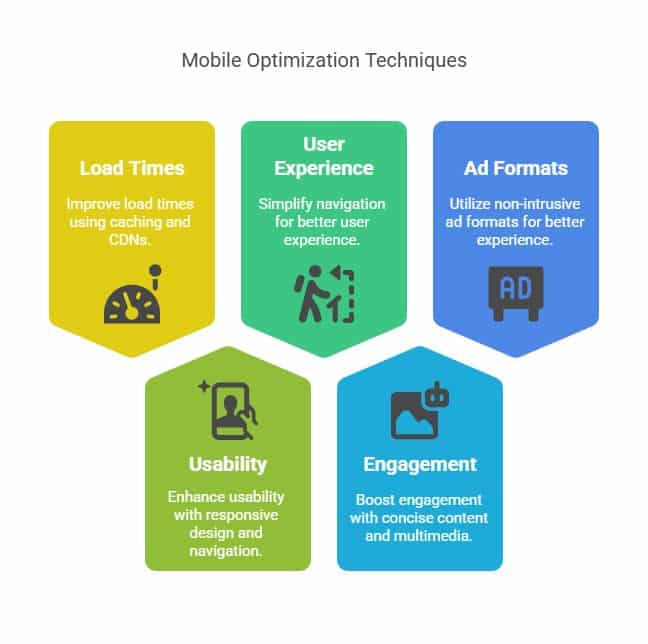
For beginners aiming to improve mobile SEO, focusing on mobile speed is essential. Fast load times not only improve user experience but also boost search engine rankings. Start by implementing responsive design so your website adjusts smoothly across different devices, ensuring it’s user-friendly and visually appealing. Simplify navigation by using clear calls-to-action (CTAs) and a consistent structure, helping users find what they need easily. Optimize mobile content by keeping it concise and engaging, incorporating multimedia elements like images or videos to capture attention. Also, minimize pop-ups, as they can disrupt user experience—opt for non-intrusive ad formats to keep your site accessible. By following these best mobile SEO practices for beginners, you’ll enhance your website’s performance and visibility, paving the way for more in-depth mobile optimization techniques.
Key Takeaways
- Improve load times for mobile pages by employing caching techniques, utilizing a CDN, and compressing images.
- To improve usability on all platforms, use responsive design with fluid layouts and touch-friendly navigation.
- To enhance user experience, make navigation easier using breadcrumb navigation, reduced menus, and obvious calls to action.
- For increased engagement, improve mobile content with succinct, easily readable formats and often updated multimedia components.
- Use non-intrusive ad formats to reduce unwanted pop-ups and keep an eye on user comments to improve accessibility.

1. Optimize for Mobile Speed

Why is optimizing mobile speed essential to successful SEO? Mobile page speed has a significant impact on both search engine results and user experience in today’s fast-paced digital environment. A mobile website that loads slowly can irritate visitors, raise bounce rates, and eventually result in a drop in search engine rankings. As a result, improving the performance of mobile pages is not only a technological improvement but also a strategic need.
One of the primary strategies to improve mobile page speed is through image optimization techniques. By compressing images without sacrificing quality, you can significantly reduce loading times. Tools and plugins that automatically adjust image size and format are invaluable for achieving swift performance.
Additionally, Accelerated Mobile Pages (AMP) implementation offers substantial benefits. AMP is an open-source framework that enables the creation of ultra-fast loading mobile pages. By stripping down HTML and leveraging streamlined CSS, AMP ensures that content is delivered almost instantaneously, greatly enhancing user engagement and satisfaction.
Server response time is another critical aspect of mobile speed optimization. Ensuring that your server infrastructure is robust and responsive can drastically reduce the time it takes for your site to load. This may involve using a Content Delivery Network (CDN) to reduce latency and enhance server efficiency globally.
Lastly, mobile caching strategies are essential for maintaining optimal page speed. By storing frequently accessed data locally on a user’s device, caching reduces the need for repeated server requests, thereby accelerating load times.
2. Use Responsive Design
Responsive design is a cornerstone of effective mobile SEO strategy, ensuring that your website delivers an optimal viewing experience across all devices. As mobile usage continues to rise, it’s imperative to deliver a seamless mobile user experience. Responsive design achieves this by automatically adjusting the layout, images, and interface elements to fit the screen size and resolution of the user’s device.
One of the primary responsive design benefits is the implementation of a fluid grid layout. Unlike fixed grids, fluid grids allow elements on a webpage to scale proportionately, maintaining aesthetic harmony and usability across a variety of screen sizes. This adaptability ensures that whether a user views your website on a smartphone, tablet, or desktop, the content remains easily accessible and visually appealing.
Additionally, touch friendly elements play a crucial role in enhancing mobile user experience. With the majority of mobile interactions occurring through touch, it’s essential to ensure buttons, links, and other interactive components are appropriately sized and spaced to prevent user frustration and accidental clicks. This consideration can significantly impact the user’s perception of your site’s usability and professionalism.
Adaptable images are another vital component of responsive design. By using techniques such as CSS media queries or modern HTML attributes like ‘srcset’, images can be scaled and optimized for different devices, reducing load times and bandwidth usage without sacrificing quality. This not only improves the mobile user experience but also aids in maintaining fast page load speeds, a critical factor in mobile SEO rankings.
Incorporating responsive design into your mobile SEO strategy is not merely a trend but a necessary evolution to meet the demands of today’s diverse digital landscape.
3. Simplify Navigation

Efficient navigation is crucial for enhancing mobile SEO, as it directly impacts user experience and engagement on your site. In the context of mobile devices, where screen space is limited, creating an intuitive layout is essential. A well-structured navigation system ensures that users can easily find the information they seek, ultimately improving the overall mobile user experience.
To simplify navigation effectively, consider the following strategies:
- Incorporate Touch Friendly Elements: Mobile users primarily navigate through touch. Therefore, buttons and links should be large enough to be easily tapped without frustration. This involves using ample spacing between interactive elements to prevent accidental clicks and enhance usability.
- Use Clear Call to Action (CTA): CTAs guide users toward desired actions, such as making a purchase or signing up for a newsletter. Make sure your CTAs are prominently placed and easily identifiable. This not only aids navigation but also encourages conversions by providing users with a clear path to follow.
- Implement Breadcrumb Navigation: Breadcrumbs offer a secondary navigation option that helps users understand their current location within your site’s hierarchy. This feature is particularly beneficial for websites with multiple layers of content, as it allows users to backtrack easily without relying on the primary menu.
4. Enhance Mobile Content

To elevate your mobile SEO strategy, focus on enhancing mobile content to ensure it resonates with users and search engines alike. Prioritizing mobile-friendly templates is essential as they adapt seamlessly to various screen sizes, ensuring a smooth user experience.
By employing templates that automatically adjust elements like text, images, and navigation, you lay the foundation for an engaging digital presence.
Incorporating engaging multimedia content is another vital step. Videos, infographics, and interactive elements capture attention and convey information more effectively than text alone. These media types not only enhance the user experience but also improve dwell time, a key factor in SEO performance.
However, ensure these elements load quickly and do not hinder site speed, as slow-loading pages can deter users and negatively impact rankings.
A clear call to action (CTA) is indispensable in guiding users towards desired actions, such as subscribing to newsletters or purchasing products. CTAs should be strategically placed and visually distinct, encouraging interaction without overwhelming the user.
Localized content strategies are also crucial for businesses aiming to reach specific geographic audiences. By tailoring content to reflect local interests, languages, and cultural nuances, you improve relevance and engagement, bolstering SEO efforts.
Lastly, accessible text formatting enhances readability and comprehension. Use headers, bullet points, and appropriate font sizes to make content easy to navigate and understand on smaller screens.
This simplicity facilitates better engagement and retention rates, favorable for both users and search engine algorithms.
5. Minimize Pop-Ups

While enhancing mobile content significantly boosts user engagement, it is equally important to pay attention to the user experience by minimizing intrusive elements such as pop-ups.
Pop-ups can obstruct content, disrupt the flow of information, and adversely affect mobile accessibility, leading to frustrated users and increased bounce rates. Effective ad placement and thoughtful design can help create a seamless mobile experience, encouraging higher user engagement and improving page load times.
Here are three essential strategies to minimize the negative impact of pop-ups on mobile devices:
- Limit Frequency and Size: Ensure that pop-ups do not overwhelm the user by appearing too frequently or occupying large areas of the screen. This approach respects the user’s journey and keeps the focus on the main content.
- Use Non-Intrusive Formats: Implement less disruptive ad formats such as banners or inline links that integrate smoothly with the content. This not only enhances mobile accessibility but also maintains a positive user experience.
- Optimize Load Times: Pop-ups can slow down page load times, leading to poor user engagement. Optimizing the loading sequence of pop-ups ensures that they do not hinder the initial content load, providing a smoother experience.
Final Thoughts
By implementing these top mobile SEO tips, beginners can significantly enhance their website’s visibility and performance on mobile devices. Focusing on optimizing mobile speed, utilizing responsive design, simplifying navigation, and enhancing mobile content will create a seamless user experience that encourages engagement. Additionally, minimizing intrusive elements like pop-ups ensures that users have a smooth interaction with the site, contributing to better rankings and overall mobile success. By following these steps, you will be on the right track toward a more effective mobile SEO strategy.
Looking to boost your website’s mobile SEO performance? Connect with Syville Gacutan, an experienced SEO Specialist in the Philippines. With a proven track record in mobile optimization, technical SEO, and search visibility enhancement, Syville can help your business achieve lasting digital success. Contact Syville today and start transforming your online presence.